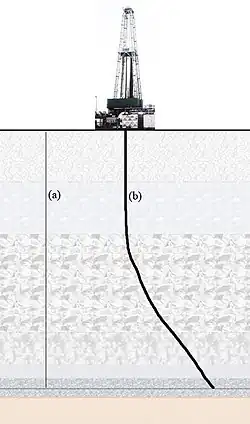
True vertical depth[1] is the measurement of a straight line perpendicularly downwards from a horizontal plane.
In the petroleum industry, true vertical depth, abbreviated as TVD, is the measurement from the surface to the bottom of the borehole (or anywhere along its length) in a straight perpendicular line represented by line (a) in the image.
Line (b) is the actual borehole and its length would be considered the "measured depth"[2] in oil industry terminology. The TVD is always equal to or less than (≤) the measured depth. If one were to imagine line (b) to be a piece of string, and further were to imagine it being pulled straight down, one would observe it to be longer than line (a). This example oil well would be considered a directional well because it deviates from a straight vertical line.
See also
References
- ↑ "True vertical depth". Schlumberger. Archived from the original on January 13, 2006. Retrieved June 7, 2023.
- ↑ "measured depth - Schlumberger Oilfield Glossary". www.glossary.oilfield.slb.com. Retrieved May 21, 2019.